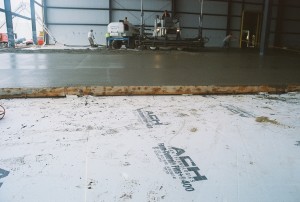By: Pat Austin, Sales Representative - Architectural Products
A common application of our Foam-Control Plus+ architectural grade EPS insulation is to provide insulation under poured concrete floors. In this situation, it is important for the designer to provide adequate compressive strength in the specified insulation to ensure that the foam isn’t crushed under load.
 To this end, the commonly used physical properties table is ASTM C578, specifically the compressive strength at 10% deformation. In this table, the specifier will have the opportunity to choose between 15, 25, 40 and 60 psi foams. However, from a design point of view, we may not want to subject the floor to a 10% deformation load. This may be an unacceptable amount of movement, creating the possibility that the floor will incur creep deformation.
To this end, the commonly used physical properties table is ASTM C578, specifically the compressive strength at 10% deformation. In this table, the specifier will have the opportunity to choose between 15, 25, 40 and 60 psi foams. However, from a design point of view, we may not want to subject the floor to a 10% deformation load. This may be an unacceptable amount of movement, creating the possibility that the floor will incur creep deformation.
By referencing ASTM D6817, Standard Specification for Rigid Cellular Polystyrene Geofoam, a designer can utilize compressive resistance at 1% deformation. Scientists have developed this data under the realization that foams subjected to loads within these limits are elastic in their response. So, in order to provide a cross-reference for the two ASTM standards, the following comparison can be used:
ASTM C578 ASTM C578 ASTM D6817
10% Deformation R-Value/inch, 40F 1% Deformation
15psi = FC+150 R4.6 7.3psi or 1,050pcf
25psi = FC+250 R4.8 10.9psi or 1,570pcf
40psi = FC+400 R4.8 15.0psi or 2,160pcf
60psi = FC+600 R4.9 18.6psi or 2,680pcf
Using 1% deformation design criteria ensures that applied loads will not permanently deflect the slab in question. Our recommendation to specifiers is to utilize D6817 in selecting the grade of foam required to carry the load in question, and then specifying the thickness based on the R-values called out in C578 to provide adequate thermal protection.
Learn more about Foam-Control Plus architectural grade EPS insulation.




